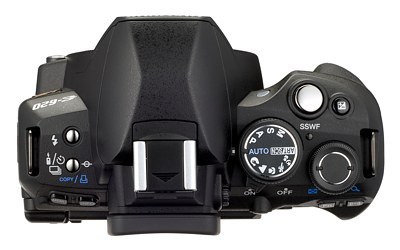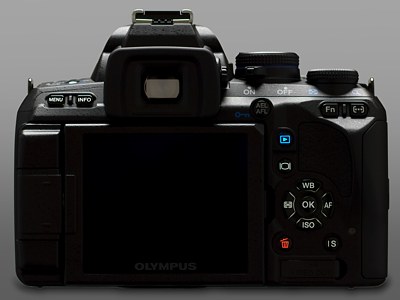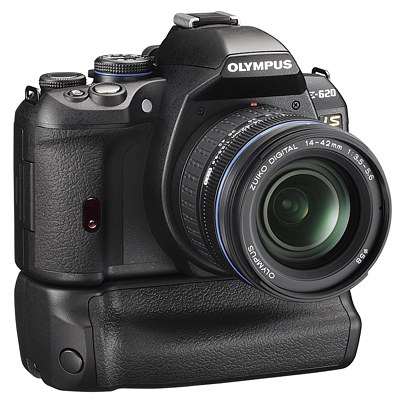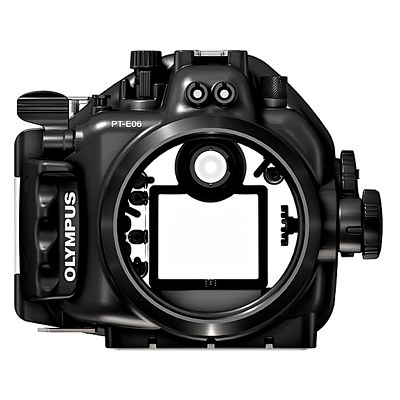
|
Olympus E-620 |

|
My other articles related to the |
|
These are the first facts, annotated specifications, and my comments about the E-620 SLR from Olympus. While the original posting of this article was based on the manufacturer's specifications, this updated version includes my experience from using the camera for a few weeks. This article may be understood as an introduction to the full review; image samples are also available. |
|
Contents | |||
|
First of all, the name used for this model suggests that Olympus treats it as a new line, not a direct continuation of the E-510 and E-520 (which were almost the same camera). The major difference is that this is the first compact SLR (Olympus or not) sporting a tilt-and-swivel monitor; this, obviously, necessitated some radical changes in the body construction, most probably moving the internals a lot in the process. |
.t.jpg)
|
.t.jpg)
| |
| (Images by Olympus) | ||
|
Let me start from the physical parameters, as per Olympus data:
The body shape might have inherited more from the E-4xx cameras than from the E-5xx ones. The prism is a bit larger (because of slightly higher finder magnification), and the hand grip is half-way between that on the E-420 and E-520. Now let me quickly list what is new, as compared to the E-510 and E-520. The monitor has the same parameters as in the E-520/E-420: 230,000 RGB dots (slightly disappointing), 2.7" diagonal (41×55 mm), 8% larger than in E-510/E-410. In a major step ahead, though, it tilts and swivels, which is a huge improvement if you are using it for Live View applications. In table top and macro photography this is worth more than all other improvements in the new camera, and including it while keeping the camera size down is impressive. The monitor LCD type is specified as HyperCrystal III which means nothing to me; it is claimed to deliver better preview, whatever that means. I take such claims with a grain of salt; they are made with every new model. Only a side-by-side comparison will tell. The imager is a 12-megapixel Live MOS chip by Panasonic, delivering images 4032×3024 pixels in size, the same as in the E-30. It is unclear if this is actually the same chip. My experience with the E-30 shows that mid-range and premium Zuiko lenses are capable of filling these pixels with detail, although the increased pixel count has more psychological than practical advantage. New autofocus sensor uses seven (as opposed to three) points. In addition to looking better on paper, this may be of help in some applications (casual snapshots or tripod shooting). The sensors are arranged in a 5×3 cross pattern.
More importantly, five of these points are of the cross-type, and all use the interleaved twin sensor technology. This should result in faster and more accurate autofocusing. According to the specs, the E-620 will focus in half the light needed by its older three-digit siblings ( Like the E-30 before it (but unlike other E-System cameras), the E-620 offers an option of autofocus calibration in three detail levels: global (per camera), lens-assigned (defined inividually for up to 20 lenses), or specific to an individual AF point for a given lens (which may be an overkill). ISO range from 100 to 3200 (like E-3 and E-30), doubling the top value in the E-4x0/E-5x0 series. Most probably, the imaging pipeline has been inherited from the E-30, which is a good news. Just don't expect much from ISO 3200. External WB sensor: If you insist on using Auto white balance, this will help the camera to get it right. Still, setting WB by hand is usually better. Sequential shooting rate of 4 frames per second brings the E-620 to the top of its price class. This is up from 3 FPS in the E-510 and 3.5 FPS in E-520, the same as in the Nikon D90. The memory buffer can hold five raw images, so this will be the maximum length of a raw image sequence at 4 FPS. At the compression rate 1:8 the sequence length should be practically unlimited if the memory card is fast enough. The buffer size is probably 64 MB, unchanged from the E-510, where it could store seven raw images; the lower number in the new camera is explained by the 20% increase in image size. The viewfinder magnification has been increased to 0.96× (from 0.92×), while the coverage remains at 95% (linear). While a 4% increase is not a lot, it should be noticeable, bringing the E-620 at par or slightly ahead competing models in apparent viewfinder size (at least in terms of image height). The in-finder information display is now arranged horizontally below the viewing screen, which, again, addresses one of my complaints about the E-4xx/E-5xx family. Smaller battery can be understood as a plus (reduction in weight and size) or a drawback (less capacity). The BLS-1 used in the E-620 (and in the E-4xx series) holds about 75% of the charge of the BLM-1 (all other Olympus SLRs), so the difference is not dramatic. Olympus was able to reduce the power usage in almost every new model (I could see that on the E-30, which has the same imaging engine and monitor), so this would become a non-issue, except for the people who may have to use two different batteries (and chargers) for two cameras. Those who like more protruding grips would not mind a larger battery at all, even at the expense of extra 30 g (roughly one ounce) in weight. Double exposure: some users may find that useful; I prefer to do this in postprocessing. (Introduced in the E-30, where it could combine up to four frames.) Art Filters, or Creative Modes: don't even get me started on that feature, which was most probably invented in the marketing, not engineering division. Still, some people may like playing with it for a while, and it has more of a reason to exist on an "entry-level" camera than on a more "serious" (whatever that means) one. Cropping to various aspect ratios: may be useful to those who do not know how to crop a picture on a computer. The crop outline is provided only in Live View, not in the viewinder. Maybe not entirely useless, but fairly close. Most of the features in the E-620 are inherited from its older siblings, in particular the E-520 from 2008. Here is a brief list for those who are not familiar with the Olympus SLR line. If you are familiar with recent Olympus SLRs, you may prefer to skip this section. Many of these features, long taken for granted and forgotten about by Olympus users may be uncommon or just unavailable on cameras by other manufacturers, and not just in this price range. The Four Thirds standard defines the sensor size and lens mount, including the electrical coupling with the camera body. While nominally open, the standard is actually supported only by two camera makers (Panasonic being the other one), and one independent lens maker (Sigma). The four Thirds sensor is 13×17.3 mm in size, a bit smaller than the commonly used APS-C one used in most other digital SLRs. For the discussion of the difference and its implications (or lack thereof), see another article. The dust removal system based on a vibrating filter in front of the sensor was first introduced by Olympus in 2001 and originally shunned by other manufacturers as something not really needed. Guess what: almost all digital SLRs of today use a similar solution. I have reasons to believe that the system in E-System cameras may still be most effective. Live View, transforming your SLR into what basically is an electronic viewfinder camera, was another first by Olympus, dating back to the E-330 of 2006. While of marginal, if any, usability in normal shooting, where SLR viewing is still unmatched, this can be useful in some applications, like macro- and microphotography, table-top, low- or high-angle shooting, and infrared. In all these applications Live View is seriously crippled if the monitor screen angle cannot be adjusted. Of other brands, only Panasonic (L1, L10) and Sony (A300, A350) and, most recently, Nikon (D5000) offer this feature, first introduced (among interchangeable-lens SLRs) in the E-330. Oh, well, in two years it will become standard. Contrast detection autofocus in the Live View mode. For many applications this may be just a matter of convenience; for others (infrared!) — an essential feature. Introduced in the E-520 and E-420, this only works with a few newer lenses, including both zooms often bundled with Olympus SLRs. Face Detection: obviously, in Live View only. I was never fond of this novelty. It is not also reliable, at least it wasn't in the E-520. In that camera it had, at least, a more entertaining name: Face and Back Control. Image stabilization system located in the camera body works with any lens, belonging to the system or not. While Olympus claims an advantage of up to 4 EV (F-stops), my measurements for the E-510 and E-3 indicate an improvement ranging from 1 EV at the lens focal length of 12-14 mm to 2 EV at 150 mm; for longer lenses this probably will increase by one EV more. I haven't checked (and nobody did, as far as I know) how inflated such claims by other camera makers may be. Adjustable noise filter. Because most of the general public seems to be allergic to noise, all cameras smooth it out in the image processing pipeline, at the expense of some other aspects of image quality. Discerning users would want to adjust the degree of this process.
Dual card slots. In addition to the (almost) omnipresent Compact Flash card, Olympus cameras (starting from the E-500) have a second slot, accommodating the proprietary xD-Picture card standard. While this may be the Control Panel on the LCD monitor, offering a quick access to almost all parameters likely to be changed during a shooting session, without a need to do it through the menu system. Other camera brands are catching up with the concept, but the original Olympus approach, barely changed since the E-500 is still, in my eyes, most usable. (Disclaimer: my familiarity with Olympus gear may be affecting my judgement.) Raw or JPEG image file format, or both for the same picture, plus an option to perform a raw-to-JPEG conversion in-camera for any previously saved raw frame, with adjustable conversion parameters. The highest-quality JPEGs use a compression ratio of 1:2.7, lowest (best) in the industry; that, in addition to the excellent Olympus JPEG engine, is why I rarely, if ever, have to resort to the raw format. Of course, you may. Picture Modes: Vivid, Natural, Muted, Portrait, and Monochrome allow the user to choose a digital equivalent of film type. Each defines a combination of contrast, color saturation, and image sharpening, and they can be accessed (and modified) easily from the Control Panel (see further down), without digging into the menu system. (Believe me, this does make a difference!). These are persistent, i.e. the camera remembers each mode settings; there is also one user-defined slot. Applied at the stage of raw-to-RGB conversion, Picture Modes do not affect raw images. Shadow Adjustment technology (here referred to as Auto Gradation). It is supposed to stretch the tonal range of shadow areas, extracting extra detail, and also to protect the highlights. I have used this feature on the E-30, and I'm still not sure how useful it really is, compared with image adjustment in postprocessing. An actual "High Speed" USB-2 PC connection, with the camera acting as a storage-class device, being seen by any computer as an external drive; no special drivers or proprietary software necessary (not so obvious: ask any Canon user). The built-in flash (GN 12 m, the same as in E-5x0) can be used for remote control of up to three groups of compatible Olympus flash units, including full through-the-lens exposure automation. For these external flashes, synchronization is possible at any shutter speed (not just those for which the shutter becomes fully open). This is rather a professional, studio-use feature, and I've never tried it, but it does not come in your way if you are not using it, so why not? Setting WB by reference (off a white paper sheet), in addition to the normal presets and Auto. One of my favorite features, delivering very good results in previous Olympus models I've checked. Shutter speeds up to 1/4000 s, self-timer, mirror lock. With a camera as generously specified as this one, the list of missing features (or, perhaps, those just I consider missing) will be quite short. I will also try to limit it to the omissions which do not seem to be justified by weight, size, cost, or technology limitations; in other words, to easily fixable issues or questionable design decisions.
What I'm not missing (for the reasons mentioned above) are: eyepiece shutter and weatherproofing. Also (if for different reasons): movies, sound recording, MP3 player, or a capability to make phone calls. |
|
The general layout of the new camera is similar to that of the previous ones; users of the E-510 or E-520 should feel at home with the E-620 right away. The body is a bit more "sculpted", but the finish seems very much alike.
The mode dial is identical to that in the E-30. It does not have a slot for a user-defined configuration, but gives one to the Art/Scene modes, a questionable design decision (see the previous section). |

| ||||||
| (Promotional image by Olympus) | |||||||
|
The external controls have been refined and slightly improved compared to the E-510/E-520; most of the changes are due to the adjustable monitor angle (the room needed for the hinge; nothing comes free), but things turned out better, I think. Here is a brief walk-through:
Overall, a very thoughtful job of utilizing the limited real estate on the camera's body for external controls. This may be, actually, the first Olympus SLR about which I'll find nothing to bitch about in this aspect (and this includes my newly-purchased E-30 I'm very happy with), Almost: the lack of user-defined position on the mode dial is an irritating omission for those who would like to have a quickly recallable, personalized setup they can modify (like, say, the portrait mode on the same dial).
| A touch of luxury: most of the control buttons are illuminated (probably LEDs, which means negligible power usage). While I never thought about it, in the past I experienced situations when this would come very handy. Besides, the feature also makes a great conversation item.
| 
(Image by Olympus)
|
| The choice and quality of Four Thirds lenses (mainly by Olympus) gained the deserved recognition only recently; I know people who bought an Olympus body primarily to have access to the premium glass. On the low end, the "kit" Olympus zooms are also seen as perhaps the best of that kind. The kit lens bundled with the E-620 is the 14-42 mm F/3.5-5.6 ZD. It is a delightful, cheap (plastic mount) lens, putting to shame possibly all zooms bundled with other makers' cameras in this price range (don't worry, those also usually have mounts made of plastic). I have two better "standard" zooms, but use this one quite often, as its weight and size are just laughable (190 g, 61 mm barrel length) — but the performance is not. For the newcomers to Olympus SLRs: to achieve the same (diagonal) image angle on a standard 35 mm frame, you have to use a lens with double the focal length. For example, the kit zoom mentioned above would have to be 28-84 mm on a film camera. To compare a Four Thirds lens with one for an APS-C camera, multiply its focal length by 1.25 (Canon) or 1.33 (Nikon and others). You will be hard pressed to find lenses performing like the 7-14 mm, 12-60 mm, or 50 mm Macro ZD on any platform and at any price. In addition, Four Thirds cameras allow for using almost any legacy lenses from other systems, with a proper adapter (easily available on eBay or elsewhere). While, obviously, only manual focusing can be used, and metering has to be done in stepped-down aperture priority mode, image stabilization will work just fine. This is due to a shorter distance between the image sensor and lens mount, allowing extra room for a lens adapter. All other digital SLR systems do not have this advantage; even if you can provide the proper mechanical fit, for most combinations the lens will not focus up to infinity, as it is moved too much forward. An option not available for the E-4xx or E-5xx series is the HLD-5 battery grip/holder (different than the one shared between the E-3 and E-30). The holder accepts two BLS-1 batteries; i.e., the same type as used by the camera. The E-620 will also have its own underwater housing, PT-E06, submersible down to 40 meters. | |||

|

| |
| (Promotional images by Olympus) | ||
|
Other accessories: cables, eyecups, remote controls, remain compatible with the E-4xx and E-5xx models. The E-620 became be available in the States in May, 2009, sold in two configurations: body only or with the 14-42 mm F/3.5-5.6 ZD lens, at $700 and $800, respectively. This depends. My traditionally given advice is not to reach for your plastic just because someone came up with the latest and greatest model, regardless of how good that camera may be. There will be an even later, even greater one in six months, and then six months after that. If you are a current Olympus user, consider if you really need to upgrade. If you are using a camera from 2005 or earlier, then probably yes. In such case compare the features of the E-3, E-30, and E-620, and choose which suits your needs and preferences best. My initial experience with the E-620 shows its image quality to be very close to that of its bigger siblings. Most probably, weight/size, weatherproofing (E-3), viewfinder, and handling will be decisive factors. If the price is important, then, obviously the E-620 is the best value. If you are now using an E-510, E-410, E-520, or E-420, then, most probably, you do not need to spend your money now — unless you are really sure you need the adjustable monitor angle (or, in case of the 4xx series, image stabilization). Both are nice, but in rare cases essential, features. Don't become a gearhead (like myself). If you are considering a switch from another system, think again. The grass is always greener on the other side. All current dSLR models are capable of delivering at least very good results. Just trying another brand will not help. Only if you are clearly dissatisfied with a particular feature (or lack thereof) in your current system, and you are sure Olympus will solve this problem, only then consider jumping the ship. If you are looking for your first SLR, you will most probably not be disappointed with the E-620. It may have more features and capabilities than you need at the moment, but they will not obstruct your path to simple picture-taking. As your technical skills and familiarity with the camera grow, you will use it more fully. Oh, yes, did I mention the value for money? Get one now and thank me later for the advice. And, sorry, I'm not able to offer any buying recommendations via email. On one hand, this takes lots of time if I want to be serious about it; on the other — without knowing your needs, skills, and preferences this would be a futile exercise. While at the original release of this article there were just a few available write-ups of the E-620, this is changing:
|

|
My other articles related to the |
|
Olympus® is a registered trademark of Olympus Corporation.
This page is not sponsored or endorsed by Olympus (or anyone else) and presents solely the views of the author. |
| Home: wrotniak.net | Search this site | Change font size |
| Posted 2009/02/24; last updated 2009/06/25 | Copyright © 2009 by J. Andrzej Wrotniak |